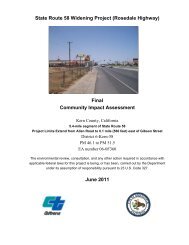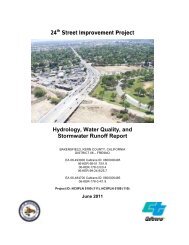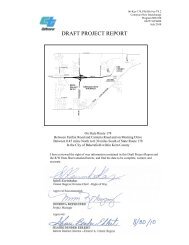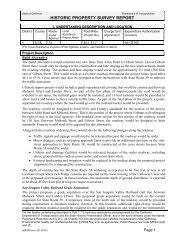State Route 58 Widening Project - Bakersfield Freeways
State Route 58 Widening Project - Bakersfield Freeways
State Route 58 Widening Project - Bakersfield Freeways
You also want an ePaper? Increase the reach of your titles
YUMPU automatically turns print PDFs into web optimized ePapers that Google loves.
Chapter 3 Results: Environmental Setting<br />
Resident bird species observed in the BSA during surveys include killdeer<br />
(Charadrius vociferous), rock pigeon (Columba livia), mourning dove (Zenaida<br />
macroura), Anna’s hummingbird (Calypte anna), western scrub-jay (Aphelocoma<br />
californica), American crow (Corvus brachyrhynchos), northern mockingbird (Mimus<br />
polyglottos), European starling (Sturnus vulgaris), house finch (Carpodacus<br />
mexicanus), and house sparrow (Passer domesticus).<br />
Migrant bird species observed in the BSA during surveys include Say’s phoebe<br />
(Sayornis saya), western kingbird (Tyrannus verticalis), northern rough-winged<br />
swallow (Stelgidopteryx serripennis), cliff swallow (Petrochelidon pyrrhonota), barn<br />
swallow (Hirundo rustica), yellow-rumped warbler (Dendroica coronata), and<br />
white-crowned sparrow.<br />
Raptor species observed in the BSA include red-tailed hawk (Buteo jamaicensis),<br />
American kestrel (Falco sparverius), great horned owl (Bubo virginianus), and<br />
burrowing owl (Athene cunicularia). These species forage in the BSA and may nest<br />
in the BSA.<br />
Mammals<br />
Mammals observed in the BSA include desert cottontail (Sylvilagus audubonii),<br />
black-tailed jackrabbit (Lepus californicus), California ground squirrel (Spermophilus<br />
beecheyi), striped skunk (Mephitis mephitis), coyote (Canis latrans), San Joaquin kit<br />
fox, and red fox (Vulpes vulpes). Rodents that may occur in the BSA include house<br />
mouse (Mus musculus) and Botta’s pocket gopher (Thomomys bottae). Medium- to<br />
large-sized mammals expected to occur in the BSA include Virginia opossum<br />
(Didelphis virginiana), common raccoon (Procyon lotor), and American badger<br />
(Taxidea taxus).<br />
Bats occur throughout most of Southern California and may use some areas of the<br />
BSA as foraging habitat, however, no bats or sign of bats were observed during<br />
surveys. Most of the bats that could potentially occur in the BSA are inactive during<br />
the winter and either hibernate or migrate, depending on the species. Cavities in trees<br />
and man-made structures (such as bridges and culverts) provide potential roosting<br />
opportunities for bat species. Common bat species that may occur in the BSA include<br />
big brown bat (Eptesicus fuscus), California myotis (Myotis californicus), Brazilian<br />
free-tailed bat (Tadarida brasiliensis), and western pipistrelle (Pipistrellus hesperus).<br />
<strong>State</strong> <strong>Route</strong> <strong>58</strong> <strong>Widening</strong> <strong>Project</strong> Biological Assessment 27








